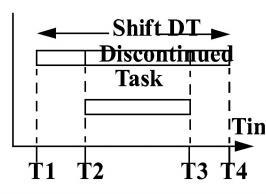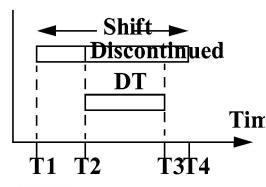
You are here: Building the Model: General Elements > Shifts & Breaks > Shift Downtime Principles > Resource Downtime Principles
Resource shift downtimes work exactly like location shift downtimes with the exception that if the off-shift downtime is preempted by some other downtime, the original off-shift downtime never resumes. The following examples show how a resource that is off shift is affected by a preemptive request by another entity (example 1) and by downtime preemption (example 2).
Suppose a resource, repairman, is off-shift. An important machine goes down unexpectedly. Because this machine is a bottleneck in the operation, it is vital to repair the machine as quickly as possible. The repairman is called in and takes 30 minutes to fix the machine. The logic for the downtime to call him back is "USE Repairman, 600 FOR 30 min". This will preempt the shift downtime and use the repairman to repair the machine even though the repairman is off-shift. Once the repairman has repaired the machine, he returns to his shift downtime until he is scheduled to go back on shift. The repairman's shift downtime will end at the originally scheduled time regardless of the fact it was preempted by a repair activity.

Although the shift downtime is scheduled to last from time T1 to T4, the actual downtime lasts from T1 to T2 and then from T3 to T4.
This example shows the effect of a preemptive downtime occurring for a resource already off-shift due to a shift downtime. Since resource downtimes are not overlapping, as in the case of location downtimes, the shift downtime in progress is discontinued and the preemptive downtime takes control of the resource because it has a priority greater than or equal to five-hundred (remember that a downtime priority needs to be only one level higher than another downtime priority to preempt it). The effect in this example is that the total downtime is actually shorter than it would have been had the original shift downtime been completed.

Although in practice, situations like the example above are unlikely to occur, it is important to understand that the above condition is possible. Typically, preemptive downtimes are due only to some type of location or resource failure, in which case, the downtime occurrence would be based on usage and not clock time. If a preemptive downtime is based on usage, the situation in the example above could not occur because the location or resource would not be in use, and would not accumulate usage time.